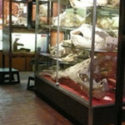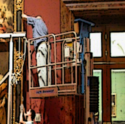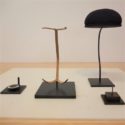
Once an object is placed in a public exhibition environment, it is exposed to a wide variety of threats to its condition. This four-part webinar course will provide practical knowledge about the materials, methods, and equipment that provides both protection to collections and also the safety to the museum staff and visitors. This course will cover the basics and standards for lighting, exhibition components, mount making as well as installation and object handling equipment.
Course Coordinator: Mark Wamaling, Chair of PACCIN
This course was originally presented as a 4-week live course
between October 25 and November 15, 2018.
The webinars were recorded and are now available along with the original course handouts, quizzes and assignments.
Course assignments are for self-study purposes only and will not be reviewed by instructors.
The Credly badge is no longer available for this course.

Webinar One: Museum Lighting: Balancing Display and Preservation
Scott Rosenfeld LC, IES, Lighting Designer at the Smithsonian American Art Museum and Renwick Gallery
A museum lighting designer confronts the fact that the same light which allows us to see exhibits is also an agent of destruction. In this webinar we will explore this conundrum and provide standard techniques for making exhibits look great today while preserving collections for future generations. The essential element to this process is mastering the control of each property of light: intensity, distribution, movement, spectrum and angle of incidence. This webinar will be richly illustrated with examples from the Smithsonian American Art Museum and Renwick Gallery showing how light can be used so artworks may be better seen, understood, experienced and preserved. Special attention will be given to explaining common lighting metrics and the variety of lighting sources used in museums from daylight to LED.

Webinar Two: Exhibition Furniture and Fixtures: A How-to Guide for Small Institutions
Jim Williams, Exhibition Designer/Preparator for the Kent State University Museum
This webinar explores a variety of techniques, materials and hardware used to create the structures necessary to exhibit cultural artifacts at their best. Focus will be on easy-to-build fixtures that require beginner- to intermediate-level skills. Discussions include how to set up a shop, basic construction methods, sourcing materials and hardware, coatings and sealants, environmental and security concerns, and when to do it yourself and when to hire the job out.

Webinar Three: Installation and Object Handling Equipment: Handling Equipment for the Safety of the Object and Handler in Mind
Brent Powell, Independent Consultant based in New York City
The priority of handling any object is to safely move it from Point A to Point B while assuring its inherent care and protect its integrity. At the same time, the handler must be using proper handling techniques to assure their physical safety. Often time we focus so much on the safety of the object that we minimally address the physical needs of the handler. The two must go hand in hand. This webinar will address the equipment and materials used for installation of objects and the releavant handling methods. Case studies will address proven practices within the museum and commercial work environment. Special focus will include current standards of staff safety training and purchasing appropriate safety equipment.

Webinar Four: Mountmaking for Display and Conservation (Collections Safety Does Not Have to be Boring)
Jamie Hascall, Principal at Mountmaking Focus Studio in Seattle
Exhibit mountmaking is as much a thought process as a set of fabrication skills. Learn to assess the problems presented in caring for collections while integrating them into exhibit or display settings. Explore the materials used for mounts, their attributes and basic building techniques; and see examples of mount solutions for typical objects and the decisions involved with each. Learn to address stabilization and conservation challenges while building exciting exhibits.





